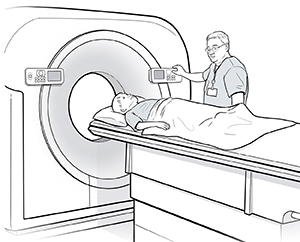When Your Child Needs a CT Scan
A CT scan is an imaging test. It combines X-rays with computer technology. A CT scanner rotates X-ray beams through the body part being tested. A computer then uses the X-rays to create images. CT images are more detailed than regular X-ray. A CT scan can be used for any part of the body, such as bones, muscles, fat, and organs. The scan may take only a few minutes. But the entire test lasts about 30 to 60 minutes.
Before the scan
Here are some tips to help you prepare:
-
Follow any directions the healthcare provider gives your child for not eating or drinking before the scan.
-
Remove any metal objects (such as glasses, belts, or clothing with zippers) from your child’s body. These things may interfere with X-rays and affect the results. It's OK if your child has dental braces and fillings.
-
Follow all other directions given by the healthcare provider.
Let the technologist know
For your child’s safety, let the healthcare provider know if your child:
During the scan
A CT scan is done by a radiology technologist. A radiologist is on call in case of problems. This is a healthcare provider trained to use CT or other imaging methods to test or treat patients.
Generally, a CT scan follows this process:
-
Typically, you will stay with your child in the testing room until the scanning begins. However, if needed you may be able stay in the room with your child if you wear a lead apron to prevent radiation exposure.
-
Your child lies on a narrow table. The table slides into a doughnut-shaped hole that’s part of the CT scanner.
-
Your child needs to keep still during the scan. Movement affects the quality of the results and can even result in a repeat scan. Your child may be restrained or given a medicine that makes them relax or sleep (a sedative). The sedative is taken by mouth or given through an IV (intravenous) line. A trained nurse often helps with this process. In rare cases, medicine that makes your child sleep (anesthesia) is also used. You’ll be told more about this if needed.
-
A special contrast dye may be used to improve image results. Your child is given contrast dye by mouth, by IV, or in some cases by rectum. The dye may make your child feel warm or leave a strange taste in their mouth. The effects vary depending on what kind of contrast dye is used and how it’s given.
-
The technologist is nearby and sees your child through a window.
-
Your child may hear whirring, buzzing, or clicking noises. The table moves as images are taken.
-
If awake, your child can speak to and hear the technologist through a speaker inside the scanner. Older children may be asked to hold their breath at some points for better image results.

After the scan
Here is what to expect after the scan:
-
If a sedative is given, your child may be taken to a recovery room. It may take 1 or 2 hours for the medicine to wear off.
-
Unless told not to, your child can return to their normal routine and diet right away.
-
Any contrast dye your child is given should pass through the body in about 24 hours.
-
The CT images are reviewed by a radiologist, who may discuss early results with you. A report is sent to your child’s healthcare provider, who follows up with complete results.
Helping your child get ready
You can help your child by preparing them in advance. How you do this depends on your child’s needs:
-
Explain the test to your child in brief and simple terms. Younger children have shorter attention spans, so do this shortly before the test. Older children can be given more time to understand the test in advance.
-
Make sure your child understands which body parts will be affected in the test.
-
As best you can, describe how the test will feel. The CT scanner causes no pain. If your child needs to be sedated, an IV may be inserted into the arm. This may sting briefly. If awake, your child may become uncomfortable from lying still.
-
Let your child ask questions.
-
Use play when helpful. This can include role-playing with a child’s favorite toy or object. It may help older children to see pictures of what happens during the test.
Possible risks and complications
Risks and complications may include:
-
Radiation exposure from X-rays. This exposure is felt to be low level and the scan is adjusted to use the lowest amount of X-ray radiation as possible.
-
Reaction to sedative or anesthesia, such as headaches, shivering, and vomiting
-
Allergic reaction to contrast dye, such as hives, itching, or wheezing. Uncommonly, the reactions may be severe resulting in significant respiratory distress.
-
In rare cases, kidney injury from IV contrast dye, if given
Online Medical Reviewer:
Dan Brennan MD
Online Medical Reviewer:
Jessica Gotwals RN BSN MPH
Online Medical Reviewer:
Neil Grossman MD
Date Last Reviewed:
12/1/2022
© 2000-2025 The StayWell Company, LLC. All rights reserved. This information is not intended as a substitute for professional medical care. Always follow your healthcare professional's instructions.